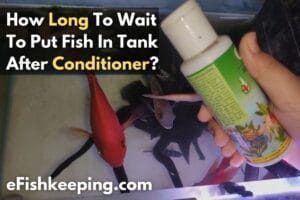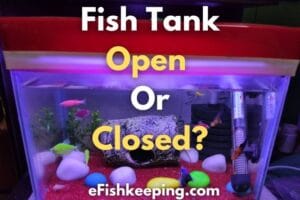Owning a pet fish reduces stress, promotes better sleep, and can be a great way to teach your little ones about responsibility.
But sometimes, setting up an aquarium for your new friend can be a little confusing. So, can you add gravel after water?
You can add gravel after adding water, but you should do this in small increments, especially if there are animals inside the aquarium. However, it’s always easier to add the gravel first and then pour the water on top.
While doing so, you should place a dish on top of the gravel bed. Pour the water gently over the dish, and the extra water will gradually fill the tank without disrupting your setup.
Can I Add Gravel After Water?
If you have an empty tank, you can add the gravel after cleaning it and then slowly add the water. This technique won’t disturb the substrate layer and will maintain the design if you’ve added several colors on top of each other.
However, you can add gravel after water to an empty tank, as long as you add it slowly and in small increments. This will allow you to distribute it evenly to create a decent substrate layer.
For a better result, you should add the gravel first, make sure it’s distributed in an even layer, and then add the water on top.
Pouring water too fast will move the gravel. So, you should either put a dish on top of the gravel or spread a newspaper sheet on top.
Once you pour the water, it will flow slowly, and you can easily remove the sheets or the dish.
Do I Put Gravel Or Water First?
It’s recommended to add gravel first, distribute it so that it forms a slope towards the front of the tank, and then add the water on top.
This technique is also better if you have different-sized gravel particles or you want to create a substrate layer made of various colors.
Adding a dish or newspaper sheet on top of the gravel won’t disturb the gravel layer. It will also maintain your design if you want to add several colors to the substrate.
You can add water first and then gravel on top; however, you’ll have to use a shovel to evenly distribute the gravel.
How Should I Add Gravel to My Aquarium?
Gravel comes in different shapes and colors to provide your fish and other aquatic animals with the perfect environment while creating a centerpiece in your room that matches the décor.
However, in order to add gravel safely, there are a few tips to follow.
- Rinse the gravel before adding it to the aquarium. If you’re using colored gravel, make sure to boil it first to eliminate any toxins that might kill your fish.
- Start by washing small batches of gravel in a bucket to separate the dirt particles and any other objects that you might find. (Read here: What happens when you don’t wash aquarium gravel)
- Soak the gravel for about 5 minutes, as this will cause the dirt and dust particles to float on top of the water, and after that, rinse it again. You can repeat this process as many times as you feel necessary until the water runs clear.
- Strain the gravel in a strainer and run water through it until it runs clear. Stick to straining and rinsing a maximum of 1 pound at a time to properly clean it.
- Wear rubber gloves to protect your hand and pour a dechlorinating chemical or water conditioner into a bucket of water. Slowly add the gravel to the bucket and let it soak for about 20 minutes to remove the chlorine.
- Take the gravel out of the bucket and add it to the strainer, and then put it into a clean bucket and let it dry.
- Add about half an inch of gravel to the bottom of your fish tank, and smooth it out with your hand.
- Put a dish on top of the gravel and slowly pour the water into the dish. The extra water will gently pour out of the dish without disrupting the gravel layer.
- Place different rocks and plants on top of the gravel to create the perfect habitat for your fish. Make sure to anchor the plants into the gravel so they don’t float around the tank. You might have to add more gravel to support the rooted plants.
Can I Add Gravel While Fish Are In The Tank?
You can add gravel while fish are in the tank, as long as you’re doing this slowly.
However, there’s a risk that adding gravel to the tank will affect your fish.
New gravel, especially if it’s porous, can carry some parasites, harmful bacteria, and other pollutants that might affect your fish.
This is why you need to pick it from a reliable source and clean it thoroughly, even if it says that it’s pre-washed.
You should also add a small amount of gravel at a time. This will guarantee that you won’t disturb the bacterial colonies or change the pH level of the tank water.
How Do I Add Gravel To My Fish Tank With Water?

The key to adding gravel to an established fish tank is to do this as slowly and as gently as possible.
Dumping gravel too fast can disturb and stress the fish. It might even injure some of the aquatic animals you have in the tank.
Here are the right steps to follow.
- Rinse the gravel and soak it for a few minutes. You can rinse it again if it still doesn’t look clean.
- Strain the gravel.
- Soak in a conditioning solution to remove the chlorine from tap water.
- Strain one more time and keep the gravel in the strainer. Let it dry completely.
- Slowly lower the strainer into the fish tank. Once you do, the fish will move away.
- Gently pour the gravel where you want to add them.
- Use the bottom of the strainer to gently even out the layer you’ve added.
- Remove the strainer, making sure that you’re moving as slowly as possible to avoid startling the fish.
How Much Gravel Do I Need in My Tank?
The rule is to add one pound of gravel per gallon of water.
If you have a new tank, you should let the water circulate and pass through the filter for at least one week before adding the fish or any other aquatic animals. This will ensure that the water isn’t toxic and the tank is safe for your pets.
Can I Add New Gravel to Old Gravel?
There’s debate whether adding new gravel is actually healthy for your fish.
Since you have an established tank, you’ll have beneficial bacterial colonies in the substrate, and adding new gravel might mess up the balance in your tank.
However, some hobbyists believe that adding new gravel will be a good idea, especially if you have plants in your tank, as it will keep them stable. In addition, these hobbyists believe that the majority of the bacteria live in the filter medium, so adding new gravel won’t cause much disturbance to the bacterial balance.
Others believe that this might affect the bacterial colonies and change the minerals in the water.
Nevertheless, you should always clean new gravel before adding it to the old one to make sure that it’s free of any debris that might harm your fish.
If you haven’t used a dechlorinated chemical, you can add a tap water conditioner to protect your pet fish from any tap water residue that might still be in the gravel.
Is It Normal For the Water to Turn Cloudy After Adding the Gravel?
The water in the fish tank will turn cloudy if you haven’t cleaned the gravel well. The dust particles stuck on the gravel will dissolve in the water, causing it to turn cloudy, although it might clear after a few days.
Nevertheless, this doesn’t mean the tank is clean, and the filter has removed this debris. The dust particles settle at the bottom of the tank and will turn it cloudy every time the gravel is disrupted.
This is why I recommended emptying the tank, removing the gravel, rinsing it properly, and then refilling the tank one more time.
Final Thoughts
You can add gravel in small increments after adding the water to your fish tank. But first, you should clean and rinse it properly to make sure that it’s free of dust and debris.
It’s best to add a layer of gravel first after cleaning, rinsing, and dechlorinating it, and then pour water gently on top so it doesn’t disrupt your setup.
Hi! I’m Praveen Ghoshal, the founder of eFishkeeping.com. Inspired by my Dad, I got interested in fishkeeping when I was a kid. Since then, I have been involved with this hobby. Currently, I have 3 fish tanks at our home, and I enjoy this hobby with my full family. Read more about me here.








